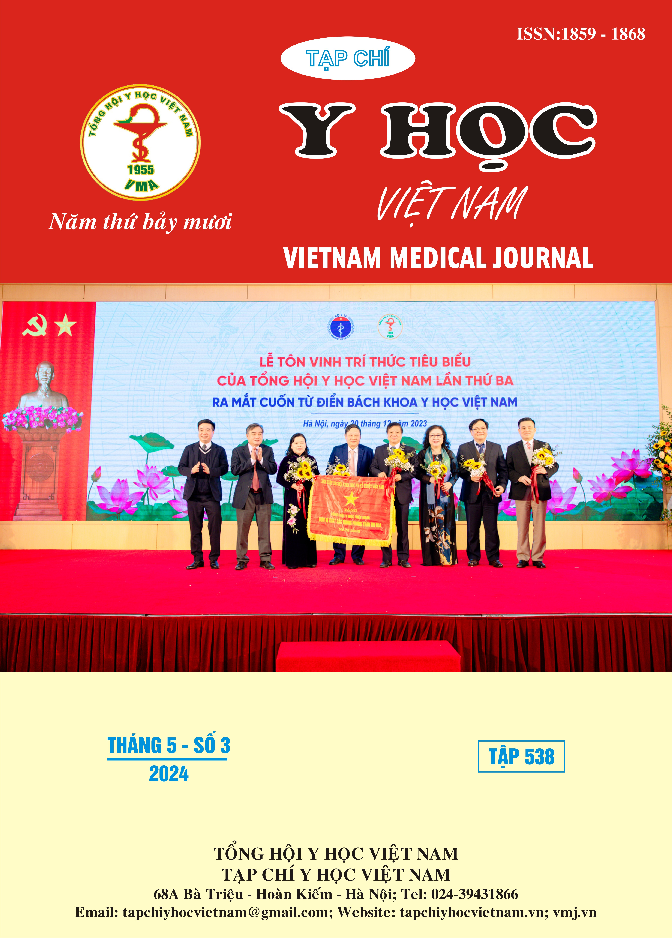INDIVIDUALIZED VANCOMYCIN DOSING WITH AUC-BASED THERAPEUTIC DRUG MONITORING BY THE BAYESIAN APPROACH IN ADULT PATIENTS AT NATIONAL INSTITUTE OF HEMATOLOGY AND BLOOD TRANSFUSION
Main Article Content
Abstract
Objective: Analyze the results of the adjusted vancomycin dosing with AUC-based therapeutic drug monitoring (TDM) via the Bayesian approach in adult patients at National institute of hematology and blood transfusion. Evaluate the impact of age, creatinine clearance and febrile neutropenia on vancomycin exposures. Method: A prospective study was conducted in hematological patients with underlying infectious diseases treated with vancomycin. Based on TDM concentrations, calculations were performed using SmartDoseAI software to identify the AUC value and suggest new dosing regimens achieving a target exposure of AUC 400 – 600 mg.h/L. Results: A total of 120 patients were included. The target AUC attainment was improved after the 1st and 2nd dosing adjustments, from 45.0% to 83.3% and 97.2%. Patients with febrile neutropenia (FN) had higher clearance of vancomycin (Clvan) (5.65 vs. 3.87 L/h, p < 0.001) and lower AUC compared to the figures of non-FN patients (412.83 vs. 475.76, p = 0.006). Additionally, both elderly patients (≥ 60 years) and those with high creatinine clearance (≥ 90 mL/min) significantly impacted on Clvan and the estimated AUC value. Conclusions: These findings emphasize the necessity of vancomycin TDM and the Bayesian approach in individualizing doses at the bedside.
Article Details
Keywords
AUC, Bayesian, adult patients, hematology, therapeutic drug monitoring (TDM), vancomycin.
References
2. Goti V., Chaturvedula A., et al. (2018), "Hospitalized Patients With and Without Hemodialysis Have Markedly Different Vancomycin Pharmacokinetics: A Population Pharmacokinetic Model-Based Analysis", Ther Drug Monit, 40(2), pp. 212-221.
3. Hughes J. H., Keizer R. J. (2021), "A hybrid machine learning/pharmacokinetic approach outperforms maximum a posteriori Bayesian estimation by selectively flattening model priors", CPT Pharmacometrics Syst Pharmacol, 10(10), pp. 1150-1160.
4. Belabbas T., Yamada T., et al. (2023), "Population pharmacokinetic model and dosing optimization of vancomycin in hematologic malignancies with neutropenia and augmented renal clearance", J Infect Chemother, 29(4), pp. 391-400.
5. Naeem D., Alshamrani M. A., et al. (2018), "Prescribing Empiric Antibiotics for Febrile Neutropenia: Compliance with Institutional Febrile Neutropenia Guidelines", Pharmacy (Basel), 6(3), pp.
6. Bùi Thị Vân Nga và cộng sự (2024), "Nghiên cứu tình hình kháng kháng sinh tại Viện Huyết học - Truyền máu TW giai đoạn 2019-2021", Tạp chí Y học Việt Nam tập 536, pp. 135-138.
7. Parra Gonzalez D., Perez Mesa J. A., et al. (2022), "Pharmacokinetics of Vancomycin among Patients with Chemotherapy-Associated Febrile Neutropenia: Which Would Be the Best Dosing to Obtain Appropriate Exposure?", Antibiotics (Basel), 11(11), pp.
8. Haeseker M. B., Croes S., et al. (2014), "Vancomycin dosing in neutropenic patients", PLoS One, 9(11), pp. e112008.
9. Alzahrani A. M., Hakami A. Y., et al. (2022), "Augmented Renal Clearance and Hypoalbuminemia-Induced Low Vancomycin Trough Concentrations in Febrile Neutropenic Patients With Hematological Malignancies", Cureus, 14(9), pp. e29568.


